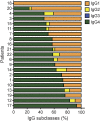Clinical manifestations of the anti-IgLON5 disease
- PMID: 28381508
- PMCID: PMC5409845
- DOI: 10.1212/WNL.0000000000003887
Clinical manifestations of the anti-IgLON5 disease
Abstract
Objective: To report the presentation, main syndromes, human leukocyte antigen (HLA) association, and immunoglobulin G (IgG) subclass in the anti-IgLON5 disease: a disorder with parasomnias, sleep apnea, and IgLON5 antibodies.
Methods: This was a retrospective clinical analysis of 22 patients. The IgG subclass was determined using reported techniques.
Results: Patients' median age was 64 years (range 46-83). Symptoms that led to initial consultation included sleep problems (8 patients; 36%), gait abnormalities (8; 36%), bulbar dysfunction (3; 14%), chorea (2; 9%), and cognitive decline (1; 5%). By the time of diagnosis of the disorder, 4 syndromes were identified: (1) a sleep disorder with parasomnia and sleep breathing difficulty in 8 (36%) patients; (2) a bulbar syndrome including dysphagia, sialorrhea, stridor, or acute respiratory insufficiency in 6 (27%); (3) a syndrome resembling progressive supranuclear palsy (PSP-like) in 5 (23%); and (4) cognitive decline with or without chorea in 3 (14%). All patients eventually developed parasomnia, sleep apnea, insomnia, or excessive daytime sleepiness. HLA-DRB1*10:01 and HLA-DQB1*05:01 were positive in 13/15 (87%) patients; the DRB1*10:01 allele was 36 times more prevalent than in the general population. Among 16 patients with paired serum and CSF samples, 14 had IgLON5 antibodies in both, and 2 only in serum (both had a PSP-like syndrome). Twenty of 21 patients had IgG1 and IgG4 antibodies; the latter predominated in 16.
Conclusions: Patients with IgLON5 antibodies develop a characteristic sleep disorder preceded or accompanied by bulbar symptoms, gait abnormalities, oculomotor problems, and, less frequently, cognitive decline. IgG4 subclass antibodies predominate over IgG1; we confirm a strong association with the HLA-DRB1*10:01 allele.
© 2017 American Academy of Neurology.
Figures


Comment in
-
Cell surface antibody-associated neurodegeneration: The case of anti-IgLON5 antibodies.Neurology. 2017 May 2;88(18):1688-1690. doi: 10.1212/WNL.0000000000003931. Epub 2017 Apr 5. Neurology. 2017. PMID: 28381512 No abstract available.
References
-
- van Swieten JC, Koudstaal PJ, Visser MC, Schouten HJ, van Gijn J. Interobserver agreement for the assessment of handicap in stroke patients. Stroke 1988;19:604–607. - PubMed
-
- Balas A, García-Sánchez F, Vicario JL. Allelic and haplotypic HLA frequency distribution in Spanish hematopoietic patients: implications for unrelated donor searching. Tissue Antigens 2011;77:45–53. - PubMed
-
- Högl B, Heidbreder A, Santamaria J, Graus F, Poewe W. IgLON5 autoimmunity and abnormal behaviours during sleep. Lancet 2015;385:1590. - PubMed
MeSH terms
Substances
Grants and funding
LinkOut - more resources
Full Text Sources
Other Literature Sources
Medical
Research Materials
Miscellaneous
